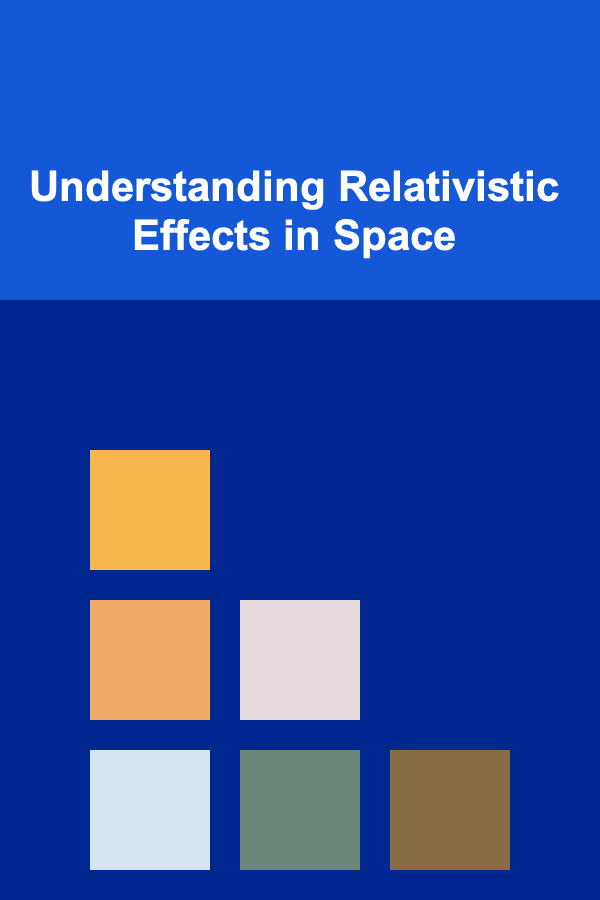
Understanding Relativistic Effects in Space
ebook include PDF & Audio bundle (Micro Guide)
$12.99$5.99
Limited Time Offer! Order within the next:

Relativity, a cornerstone of modern physics, fundamentally alters our understanding of space, time, gravity, and the universe itself. While often perceived as abstract theoretical concepts, relativistic effects are not merely mathematical curiosities; they are crucial for accurate calculations and predictions in space exploration, satellite technology, and our understanding of cosmic phenomena. This article delves into the core principles of relativity, exploring how these effects manifest in space and the practical implications for our technological endeavors.
The Two Pillars of Relativity: Special and General
Relativity comprises two major theories: Special Relativity, introduced by Albert Einstein in 1905, and General Relativity, formulated by Einstein in 1915. Each deals with different aspects of space, time, and gravity.
Special Relativity: The Realm of Constant Motion
Special Relativity is built upon two fundamental postulates:
- The laws of physics are the same for all observers in uniform motion (inertial frames of reference).
- The speed of light in a vacuum (c ≈ 299,792,458 meters per second) is the same for all observers, regardless of the motion of the light source.
These seemingly simple postulates have profound consequences. One of the most notable is the relativity of simultaneity. Events that appear simultaneous to one observer may not be simultaneous to another observer in relative motion. This is not a subjective perception; it's a fundamental property of spacetime.
Another key consequence is time dilation. Moving clocks run slower than stationary clocks, relative to an observer in a stationary frame of reference. The time dilation factor is given by:
γ = 1 / √(1 - v²/c²)
where v is the relative velocity between the two frames of reference and c is the speed of light. As the velocity approaches the speed of light, the time dilation factor increases dramatically, implying that time slows down considerably for the moving object relative to the stationary observer.
Length contraction is another effect. Objects moving at relativistic speeds appear shorter in the direction of motion to a stationary observer. The length contraction factor is the inverse of the time dilation factor (1/γ). This means the faster an object moves, the shorter it appears in the direction of its motion.
Finally, Special Relativity reveals the equivalence of mass and energy, famously expressed by the equation:
E = mc²
This equation demonstrates that a small amount of mass can be converted into a tremendous amount of energy, and vice versa. This principle underlies nuclear reactions and the operation of nuclear power plants, and also plays a role in understanding the energy generation within stars.
General Relativity: Gravity as Curvature of Spacetime
General Relativity extends Special Relativity by incorporating gravity. Instead of viewing gravity as a force, General Relativity describes it as a curvature of spacetime caused by mass and energy. Imagine a bowling ball placed on a stretched rubber sheet; it creates a dip, and if you roll a marble nearby, it will curve towards the bowling ball. Similarly, massive objects warp the fabric of spacetime, causing other objects (including light) to move along curved paths.
One of the key predictions of General Relativity is gravitational time dilation. Time runs slower in stronger gravitational fields. This means that a clock on the surface of the Earth will tick slower than a clock far away in space, due to the Earth's gravitational field. The stronger the gravitational field, the more significant the time dilation effect.
Another important effect is the bending of light. Because gravity warps spacetime, light rays traveling near massive objects are deflected from their straight-line paths. This effect has been experimentally verified through observations of starlight bending around the Sun during solar eclipses, providing strong evidence for the validity of General Relativity.
General Relativity also predicts the existence of gravitational waves, ripples in spacetime caused by accelerating massive objects. These waves were directly detected for the first time in 2015 by the Laser Interferometer Gravitational-Wave Observatory (LIGO), confirming another major prediction of Einstein's theory.
Relativistic Effects in Space Exploration and Technology
Relativistic effects are not just theoretical curiosities; they have significant practical implications for space exploration and technology.
Global Positioning System (GPS) Satellites
The Global Positioning System (GPS) relies on a network of satellites orbiting the Earth. These satellites transmit signals that are used by GPS receivers to determine their location. To achieve the required accuracy for navigation (typically within a few meters), the effects of both Special and General Relativity must be taken into account.
Special Relativity contributes to time dilation because the GPS satellites are moving at a high velocity relative to observers on the ground. The time dilation due to their velocity causes their onboard clocks to run slower by approximately 7 microseconds per day.
General Relativity contributes to time dilation because the GPS satellites are in a weaker gravitational field than observers on the ground. The time dilation due to the weaker gravitational field causes their onboard clocks to run faster by approximately 45 microseconds per day.
The net effect is a time dilation of approximately 38 microseconds per day (45 - 7). While this may seem small, without correcting for this relativistic time dilation, the GPS system would accumulate errors of several kilometers per day, rendering it useless for accurate navigation. The GPS system incorporates sophisticated algorithms to compensate for these relativistic effects, ensuring the accuracy of the system.
Interstellar Travel
For hypothetical interstellar travel at speeds approaching the speed of light, relativistic effects become much more pronounced. Time dilation would allow astronauts to travel vast distances within their lifetimes, even though many years or centuries might pass on Earth. For example, if a spacecraft could travel at 99% the speed of light, time would slow down by a factor of approximately 7 for the astronauts on board. A journey of 70 light-years would take only 10 years from the perspective of the astronauts, but 70 years would pass on Earth.
However, interstellar travel at relativistic speeds also poses significant challenges. The amount of energy required to accelerate a spacecraft to such speeds is enormous, as the mass of an object increases as its velocity approaches the speed of light (a consequence of Special Relativity). Furthermore, collisions with even tiny particles of interstellar dust or gas at relativistic speeds would be extremely energetic, potentially causing significant damage to the spacecraft. These are just a few of the major hurdles that would need to be overcome before interstellar travel at relativistic speeds becomes feasible.
Astrophysics and Cosmology
Relativistic effects are crucial for understanding a wide range of astrophysical phenomena. For example, General Relativity is essential for understanding the behavior of black holes, regions of spacetime where gravity is so strong that nothing, not even light, can escape. The extreme gravitational fields near black holes cause significant time dilation and bending of light, and the study of these effects provides valuable insights into the nature of these enigmatic objects.
Relativistic effects are also important for understanding the evolution of the universe. The expansion of the universe, the cosmic microwave background radiation, and the formation of large-scale structures are all best understood within the framework of General Relativity. Furthermore, the study of gravitational waves provides a new window into the universe, allowing us to probe events that are invisible to traditional telescopes.
High-Energy Physics Experiments
Particle accelerators, such as the Large Hadron Collider (LHC) at CERN, accelerate particles to velocities very close to the speed of light. At these speeds, relativistic effects are extremely significant. For example, the mass of a proton increases dramatically as it approaches the speed of light, and this must be taken into account when designing and operating the accelerator. The effects of time dilation also play a role in the decay rates of particles, which are affected by their relativistic velocities.
The Twin Paradox: A Thought Experiment
The twin paradox is a famous thought experiment in Special Relativity that highlights the counterintuitive nature of time dilation. Imagine two identical twins, Alice and Bob. Alice stays on Earth, while Bob travels on a high-speed spacecraft to a distant star and then returns to Earth. According to Special Relativity, Bob's clock will run slower than Alice's clock, so when Bob returns to Earth, he will be younger than Alice.
The paradox arises because it seems that from Bob's perspective, Alice is the one who is moving, so Alice should be younger than Bob. However, the situation is not symmetrical. Bob undergoes acceleration during his journey (when he accelerates to travel to the star and decelerates to turn around), while Alice remains in an inertial frame of reference. This acceleration breaks the symmetry and explains why Bob is younger than Alice.
The twin paradox is not just a theoretical curiosity; it has been experimentally verified using atomic clocks flown on airplanes. These experiments have confirmed that moving clocks do indeed run slower than stationary clocks, as predicted by Special Relativity.
Challenges and Future Directions
While Relativity has been overwhelmingly successful in explaining a wide range of phenomena, there are still some open questions and challenges. One of the biggest challenges is reconciling General Relativity with quantum mechanics. General Relativity is a classical theory that describes gravity at the macroscopic level, while quantum mechanics is a theory that describes the behavior of matter and energy at the microscopic level. These two theories are fundamentally incompatible, and physicists are actively working on a theory of quantum gravity that would unify them.
Another challenge is understanding dark matter and dark energy. These mysterious substances make up the vast majority of the mass and energy in the universe, but we know very little about them. Some physicists have proposed modifications to General Relativity that could explain the observed effects of dark matter and dark energy without invoking these exotic substances.
Future research in Relativity will focus on addressing these challenges and on exploring the implications of Relativity for our understanding of the universe. This research will involve both theoretical work and experimental observations, including the continued search for gravitational waves and the development of new tests of General Relativity.
Conclusion
Relativistic effects, arising from both Special and General Relativity, are fundamental aspects of our universe. They are not merely abstract theoretical concepts, but rather have profound practical implications for space exploration, satellite technology, astrophysics, and our understanding of the cosmos. From the functioning of GPS satellites to the behavior of black holes, Relativity plays a crucial role in shaping our view of the universe and enabling our technological advancements. As we continue to explore the universe and push the boundaries of scientific knowledge, a deep understanding of relativistic effects will be essential for future progress. The ongoing quest to reconcile Relativity with quantum mechanics and to unravel the mysteries of dark matter and dark energy promises to lead to even more profound insights into the nature of space, time, and gravity.

How to Track Your Spending and Avoid Impulse Purchases
Read More
How to Use Folders and Subfolders to Organize Pictures
Read More
The Exquisite Dance: Pairing Wine with Chocolate
Read More
Reducing Habitat Fragmentation: A Comprehensive Guide
Read More
How to Habit Track for Creative Projects
Read More
How to Create a Daily Reflection Planner for Mindfulness
Read MoreOther Products

How to Track Your Spending and Avoid Impulse Purchases
Read More
How to Use Folders and Subfolders to Organize Pictures
Read More
The Exquisite Dance: Pairing Wine with Chocolate
Read More
Reducing Habitat Fragmentation: A Comprehensive Guide
Read More
How to Habit Track for Creative Projects
Read More